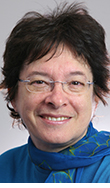As Glasscock Fellow prof preps book on U.S. synagogue design

Anat Geva
Anat Geva, Texas A&M professor of [architecture] (http://dept.arch.tamu.edu/) , is planning a book illustrating how freedom of religion, innovations in aesthetics and evolving building technology were expressed in the U.S. synagogue designs of prominent architects in the 1950s and 60s.
As one of four faculty recipients of the a [Melbern G. Glasscock Center for Humanities Research] (http://glasscock.tamu.edu/) Internal Faculty Fellowship, Geva earns $1,000 in research funding and extra time to pen the book proposal from the fellowship’s teaching load reduction.
“During the 1950s, Jewish congregations in the U.S. were ready to depart from historicism of the past and express American landscape, values and modernism in their synagogues,” said Geva. “These attempts continued during the 1960s, as modernist architects expressed spirituality, community, traditional values, and transformation in design of the modern American synagogue.”
The book, which has garnered attention from two university publishers, could serve as a blueprint for studying places where other U.S. religious minorities worship, she added.
Glasscock center fellows also participate in a colloquium series at the center, which fosters and celebrates the humanities and humanities research among scholars at Texas A&M by awarding fellowships, course development grants, publication support, and research matching awards for independent and multidisciplinary research in the humanities.
Geva, who earned a Ph.D. in architecture in 1995 at Texas A&M, studies sacred architecture, architectural design in its international, historic, and environmental context, historic preservation, and the history of building technology. She is also a Faculty Fellow at the [Center for Heritage Conservation] (http://chc.arch.tamu.edu/) .
Tags
Related Posts

Arch prof pens work on 1960s avant-garde designers Archigram
Alum heads lauded NYC row house restoration project
Prof’s essay lauds reuse of extant industrial sites

Essay highlights professor emeritus’ social activism
Follow Us
Facebook Twitter Vimeo Youtube Flickr RSS
Recent Posts

Planning prof heads study of disaster housing aid

A message from the dean

Former student remembered as expert planner

Leading educator named new head of Architecture Dept.









_thumbnail_small.png)
